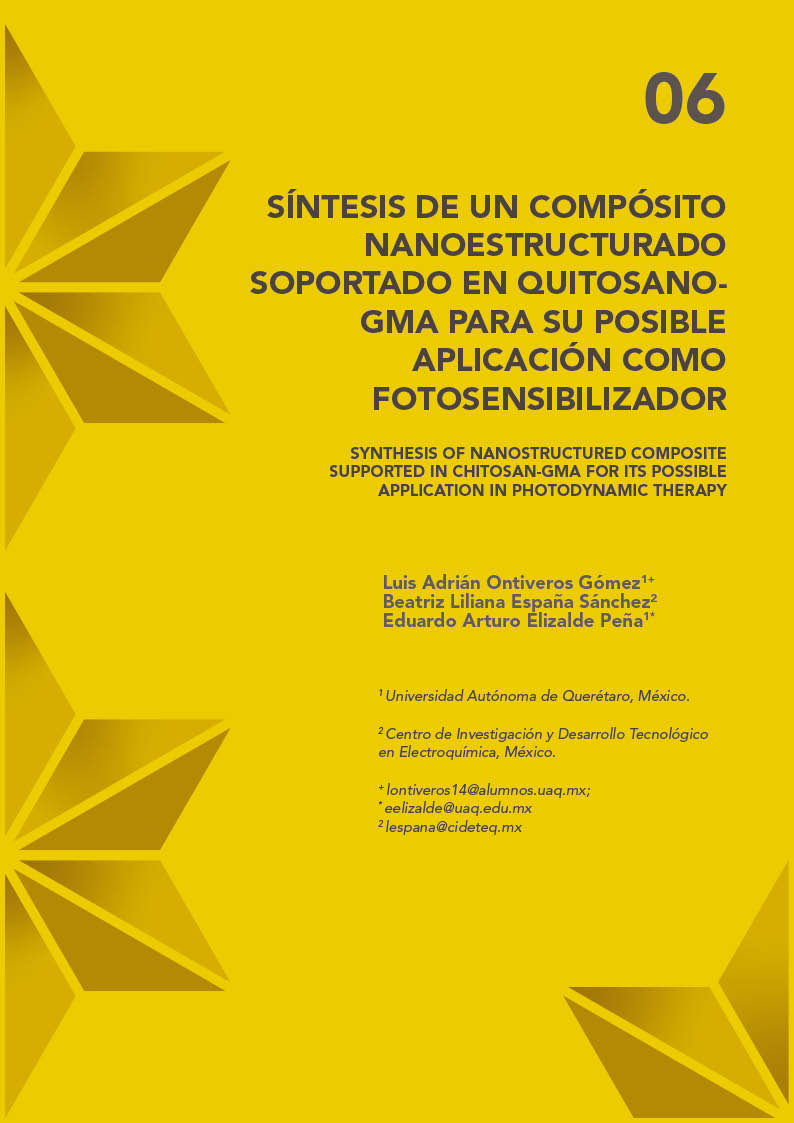Abstract
Photodynamic Therapy (PDT) is an alternative technique for cancer treatment and other diseases. To have a photodynamic effect, it is imperative to have light, molecular oxygen, and a photosensitizer. A photosensitizer is a specialized molecule that absorbs light to stimulate the promotion from ground state to a triplet excited state, that interacts directly with molecular oxygen to obtain reactive oxygen species. In the present work, it is reported the synthesis of a nanostructured composite made of carbon nanosphere (CNS) used as a photosensitizer, conjugated with gold nanoparticles (AuNPs) supported in a Chitosan-GMA matrix. It was observed through the characterization of FT-IR, UV-VIS and SEM, that de conjugation did not alter the chitosan matrix and that it also maintained the AuNPs characteristic plasmon in the samples Q-GMA-CNS-AuNPs with a concentration of 0.4 and 0.6 mM. These two compounds are considered as potential photosensitizers for their application in PDT.
References
F. S. De Rosa and M. V. L. B. Bentley, “Photodynamic therapy of skin cancers: Sensitizers, clinical studies and future directives,” Pharm. Res., vol. 17, no. 12, pp. 1447–1455, 2000, doi: 10.1023/A:1007612905378.
G. B. Kharkwal, S. K. Sharma, Y. Y. Huang, T. Dai, and M. R. Hamblin, “Photodynamic therapy for infections: Clinical applications,” Lasers Surg. Med., vol. 43, no. 7, pp. 755–767, 2011, doi: 10.1002/lsm.21080.
S. Kwiatkowski et al., “Photodynamic therapy – mechanisms, photosensitizers and combinations,” Biomedicine and Pharmacotherapy, vol. 106. Elsevier Masson SAS, pp. 1098–1107, Oct. 01, 2018, doi: 10.1016/j.biopha.2018.07.049.
T. J. Dougherty, J. E. Kaufman, A. Goldfarb, K. R. Weishaupt, D. Boyle, and A. Mittleman, “Photoradiation Therapy for the Treatment of Malignant Tumors,” Cancer Res., vol. 38, no. 8, pp. 2628–2635, 1978.
D. Kessel, “Photodynamic therapy: From the beginning,” Photodiagnosis Photodyn. Ther., vol. 1, no. 1, pp. 3–7, 2004, doi: 10.1016/S1572-1000(04)00003-1.
T. C. Z. Haixia Qiu, Michael M. Kim, Rozhin Penjweini, Jarod C. Finlay, Theresa M. Busch, Tianhao Wang, Wenshen Guo, Keith A. Cengel, Charles B. Simone II, Eli Glatstein, “Comparison between different D-Dimer cutoff values to assess the individual risk of recurrent venous thromboembolism: Analysis of results obtained in the DULCIS study,” Int. J. Lab. Hematol., vol. 38, no. 1, pp. 42–49, 2016, doi: 10.1111/ijlh.12426.
J. M. Nauta et al., “Photofrin-mediated photodynamic therapy of chemically-induced premalignant lesions and squamous cell carcinoma of the palatal mucosa in rats,” Int. J. Oral Maxillofac. Surg., vol. 26, no. 3, pp. 223–231, 1997, doi: 10.1016/S0901-5027(97)80825-9.
C. M. Peterson, R. Reed, C. J. Jolles, K. Parker Jones, R. C. Straight, and A. M. Poulson, “Photodynamic therapy of human ovarian epithelial carcinoma, OVCAR-3, heterotransplanted in the nude mouse,” Am. J. Obstet. Gynecol., vol. 167, no. 6, pp. 1852–1855, 1992, doi: 10.1016/0002-9378(92)91786-A.
A. Chiaviello, I. Postiglione, and G. Palumbo, “Targets and mechanisms of photodynamic therapy in lung cancer cells: A brief overview,” Cancers (Basel)., vol. 3, no. 1, pp. 1014–1041, 2011, doi: 10.3390/cancers3011014.
M. C. García Vior, L. E. Dicelio, and J. Awruch, “Synthesis and properties of phthalocyanine zinc(II) complexes replaced with oxygen and sulfur linked adamantane moieties,” Dye. Pigment., vol. 83, no. 3, pp. 375–380, 2009, doi: 10.1016/j.dyepig.2009.06.006.
H. Abrahamse and M. R. Hamblin, “New photosensitizers for photodynamic therapy,” Biochemical Journal, vol. 473, no. 4. Portland Press Ltd, pp. 347–364, Feb. 15, 2016, doi: 10.1042/BJ20150942.
L. B. Josefsen and R. W. Boyle, “Photodynamic therapy: Novel third-generation photosensitizers one step closer?,” Br. J. Pharmacol., vol. 154, no. 1, pp. 1–3, 2008, doi: 10.1038/bjp.2008.98.
H. Kataoka et al., “New photodynamic therapy with next-generation photosensitizers,” Ann. Transl. Med., vol. 5, no. 8, pp. 1–7, 2017, doi: 10.21037/atm.2017.03.59.
J. Li, D. Guo, X. Wang, H. Wang, H. Jiang, and B. Chen, “The photodynamic effect of different size ZnO nanoparticles on cancer cell proliferation in vitro,” Nanoscale Res. Lett., vol. 5, no. 6, pp. 1063–1071, 2010, doi: 10.1007/s11671-010-9603-4.
S. J. He et al., “CdSe/ZnS quantum dots induce photodynamic effects and cytotoxicity in pancreatic cancer cells,” World J. Gastroenterol., vol. 22, no. 21, pp. 5012–5022, 2016, doi: 10.3748/wjg.v22.i21.5012.
K. D. Patel, R. K. Singh, and H. W. Kim, “Carbon-based nanomaterials as an emerging platform for theranostics,” Mater. Horizons, vol. 6, no. 3, pp. 434–469, 2019, doi: 10.1039/c8mh00966j.
T. Murakami, “Stimuli-responsive systems of therapeutics photodynamic action of single-walled carbon nanotubes,” Chem. Pharm. Bull., vol. 65, no. 7, pp. 629–636, 2017.
D. Chen et al., “Efficacy dependence of photodynamic therapy mediated by upconversion nanoparticles: subcellular positioning and irradiation productivity,” 2017, doi: 10.1002/smll.201602053.
G. M. F. Calixto et al., “Chitosan-Based Drug Delivery Systems for Optimization of Photodynamic Therapy: a Review,” AAPS PharmSciTech, vol. 20, no. 7, 2019, doi: 10.1208/s12249-019-1407-y.
D. S. Kwag, N. M. Oh, Y. T. Oh, K. T. Oh, Y. S. Youn, and E. S. Lee, “Photodynamic therapy using glycol chitosan grafted fullerenes,” Int. J. Pharm., vol. 431, no. 1–2, pp. 204–209, 2012, doi: 10.1016/j.ijpharm.2012.04.038.
D. P. Ferreira et al., “Characterization of a Squaraine/Chitosan System for Photodynamic Therapy of Cancer,” J. Phys. Chem. B, vol. 120, no. 7, pp. 1212–1220, Feb. 2016, doi: 10.1021/acs.jpcb.5b11604.
E. A. Elizalde-Peña et al., “Synthesis and characterization of chitosan-g-glycidyl methacrylate with methyl methacrylate,” Eur. Polym. J., vol. 43, no. 9, pp. 3963–3969, 2007, doi: 10.1016/j.eurpolymj.2007.06.004.
S. Pu, J. Li, L. Sun, L. Zhong, and Q. Ma, “An in vitro comparison of the antioxidant activities of chitosan and green synthesized gold nanoparticles,” Carbohydr. Polym., vol. 211, no. December 2018, pp. 161–172, 2019, doi: 10.1016/j.carbpol.2019.02.007.
D. K. Chatterjee and Y. Zhang, “Upconverting nanoparticles as nano-transducers for photodynamic therapy in cancer cells,” Tech. Proc. 2008 NSTI Nanotechnol. Conf. Trade Show, NSTI-Nanotech, Nanotechnol. 2008, vol. 2, pp. 69–72, 2008.

This work is licensed under a Creative Commons Attribution-NonCommercial-ShareAlike 4.0 International License.
Copyright (c) 2023 Perspectivas de la Ciencia y la Tecnología

